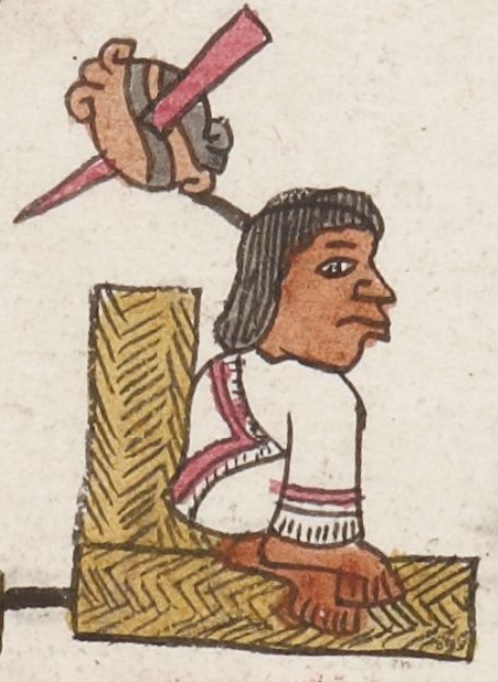Tízoc

Tízoc ( Nahuatl for thorn-reinforced leg or sick leg or chalk leg , * 1436 , † 1486 ) was ruler of the Aztec city of Tenochtitlán from 1482 to 1486 .
Life
He was a member of the old ruling family of Tenochtitlan founded by Acamapichtli († 1391) . His parents were Tezozómoc and Atotoztli , his paternal grandfather was Itzcóatl , the maternal one was Moctezuma I. His sister Chalchiuhnenetzin was married to Moquihuix the prince of Tlatelolco , his brothers Axayacatl and Auítzotl were rulers of the Mexica immediately before and after him .
Before his accession to the throne, Tízoc had already held important offices, including that of Tlacochcalcatl . During his reign he rarely undertook military campaigns aimed at conquering other areas. The military campaign traditionally carried out to ascend the throne for the purpose of capturing warriors, an attack on the northeastern small state of Mextitlán, failed, which permanently damaged Tízoc's reputation. Almost all other military operations dealt with the suppression of minor uprisings, which among other things arose because the rebellious settlements seemed to weaken the Aztec military power.
Detached from this, he made a name for himself as a religiously motivated builder. The Tízoc stone , a sacrificial stone similar to a Cuauhxicalli or Chak Mo'ol , was made on his behalf or in his honor. The surrounding frieze shows Tezcatlipoca and Tízoc as the embodiment of Huitzilopochtli during the demonstration of the gods of protection of conquered cities. The dimensions are 0.88 m in height and 2.61 to 2.67 m in cross-section, as well as a weight of 26 t. The stone was excavated by archaeologists in 1791 and is now in the National Museum of Anthropology in Mexico City . Furthermore, Tízoc ordered the expansion of the Great Temple of Tenochtitlán, but he did not live to see its completion. He died in 1486 after paying less and less attention to his government business over the years. He is generally considered a weak ruler. The reasons for his death are not entirely clear; he may have been murdered.
family
Tízoc was married to a daughter of Huehue Xiconocatzin from Temazcaltitlan. With her he had two sons and numerous grandchildren:
- Texcatl Popoca, ∞ a noblewoman from Tzaucyocan
- Diego de San Francisco Tehuetzquititzin († 1554), governor and Tlatoani of Tenochtitlan, ∞ Maria, his Cosine → descendants see there
- Huehue Mauhcaxochitzin
- Maria, ∞ Diego de San Francisco Tehuetzquititzin, her cousin → see above
- Acachollohuatzin teuhctli
- Ana, ∞ Matlatzinco, Lord of Tenantuinco
- Maria, ∞ Francisco de Guzmán Omacatzin, last lord of Ollac Xochimilco
- Francisco Axayacatzin
- Francisca Guzmán, ∞ Martín Cerón, Lord of Tepetenchi Xochimilco
- Maria
- Francisca
- Juana
- Martín Cerón
- Pedro Icelicatzin
- Pablo Tocuilteatl Chimalcoatzin
Trivia
For the Mexican film Tizoc (1956), in which the Aztec ruler was portrayed by Pedro Infante , the latter was posthumously awarded the Silver Bear at the Berlin International Film Festival in 1957 .
literature
- Nigel Davies : The Aztecs: Masters of State Art - Creators of High Culture , Econ, Düsseldorf 1979, pp. 195–202, ISBN 3-499-16950-9 .
- Hanns J. Prem : History of ancient America . Oldenbourg, Munich 1989 (2nd revised edition 2007). ISBN 3-486-53032-1 .
- Hanns J. Prem: The Aztecs. Culture - history - religion . Verlag CH Beck, Munich 2006. ISBN 3-406-45835-1 .
- Ross Hassig: Aztec Warfare. Imperial Expansion and Political Control. University of Oklahoma Press, Norman 1988. ISBN 0-8061-2121-1 .
Individual evidence
- ↑ Codex Chimalpahin , Volume 2, 1997, pp. 115-119
Web links
| personal data | |
|---|---|
| SURNAME | Tízoc |
| ALTERNATIVE NAMES | thorny leg, sick leg |
| BRIEF DESCRIPTION | Ruler of the Aztec city of Tenochtitlán |
| DATE OF BIRTH | 1436 |
| DATE OF DEATH | 1486 |
